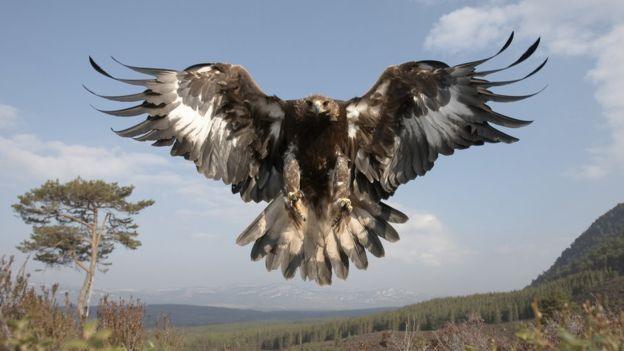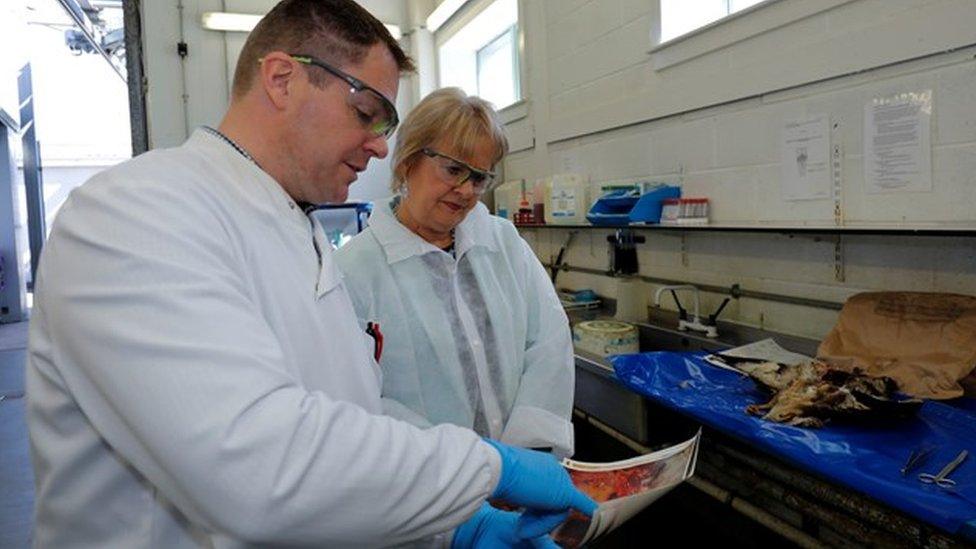One in three tagged golden eagles died 'suspiciously' in Scotland
- Published

Almost a third of golden eagles tracked by satellite have died in suspicious circumstances, according to a report for the Scottish government, external.
Scottish Natural Heritage (SNH) was commissioned to investigate the movements of the iconic birds of prey after a spate of disappearances.
It found that 41 of 131 tracked birds disappeared between 2004 and 2016.
Scientists have ruled out the tags and wind farms as possible causes for the eagles vanishing.
The study also found that the majority of cases were in areas which are managed for grouse shooting.

Six key areas where clusters of birds have disappeared have been identified
Environment Secretary Roseanna Cunningham, who commissioned the report, said: "The findings of this research are deeply concerning and will give rise to legitimate concerns that high numbers of golden eagles, and other birds of prey, continue to be killed in Scotland each year.
"There is every reason to believe that similar levels of persecution affect untagged golden eagles as well as those we are able to track via satellite tags.
"The continued killing of protected species of birds of prey damages the reputation of law-abiding gamekeepers, landowners and indeed the country as a whole."
'Outdated attitudes'
She added: "This report identifies specific problem areas which will allow Police Scotland to adopt a targeted approach and I would also encourage members of the public to report any suspicious activity to the police.
"The range of measures we will introduce over the longer-term will build on the progress that we have made to date and tackle outdated practices and attitudes.
"By looking at ways of strengthening the legal protection for birds of prey we are sending out a strong message that Scotland's wildlife is for everyone to enjoy - not for criminals to destroy for their own ends."

A package of measures have been announced in response to the report, including the creation of an independently-led group to look at the environmental impact of grouse moor management practices.
The report indicated six key areas where clusters of bird disappearances had been identified.
They are Northern Monadhliaths; Angus Glens; East Grampians including Ladder Hills; and Glaick Forest/Glen Tilt, with broader clusters identified in the Upper Tay/Forth and South Loch Ness.
Ministers say they plan to review all legal measures which could be used to target those geographical areas of concern.
'Watershed moment'
RSPB Scotland said the report's findings were "damaging and devastating".
Head of investigations Ian Thomson said he hoped it would prove to be a "watershed moment" for the conservation of birds of prey.
"The irrefutable evidence in this report, demonstrating the scale of systematic, organised criminality, is shocking - and yet it is likely that none of this would have come to light had these birds not been fitted with satellite tags," he said.
"When you add to this the disappearances of satellite-tagged white tailed eagles, red kites, goshawks, peregrines and hen harriers, not included this review, and consider that satellite-tagged birds form a very small proportion of the populations of these species, the overall numbers of eagles and other protected raptors that are actually being killed must be staggering."
He said the report validated concerns which RSPB Scotland had been expressing for decades.
"It completely bankrupts the myth that raptor persecution has been in steady decline for the last 20 years, which is something that is regularly said by representatives of the land management sector.
"What they need to do now is acknowledge the scale of the problem."

The Scottish Gamekeepers Association (SGA) said the loss of an average of four eagles a year was "totally unacceptable" and it "condemned wholeheartedly" the illegal killing of any eagle.
A spokesman for the group added: "Although this study assimilates 12 years of evidence and makes difficult reading, it does acknowledge recent improvements in some grouse moor areas previously associated with suspected persecution."
It said this had contributed to the "overall betterment" of the golden eagle's conservation status.
"That said, problems clearly still exist in some hotspot areas and, in our view, this can only be tackled by all partners having access to the same telemetry data in order to arrive at shared and targeted solutions," said the spokesman.
"If this had been happening over the past decade, there is a high likelihood these problems could have been tackled satisfactorily before now.
"The SGA does not believe the report adequately tackles the threat wind farms pose to raptor species as there is a significant amount of published data from other countries which show a negative correlation between bird survival and turbine strike.
"However, that is not an attempt in any way to detract from the report's findings."
Scottish Land and Estates said the report was "challenging reading" for the grouse shooting industry but it welcomed the announcement of an independent group to look at some of the issues it raised.
David Johnstone, the group's chairman, added: "There has been much heated debate over this issue recently and it is essential that whatever action is taken going forward, it is based on evidence and clear thinking rather than any inherent prejudice against game shooting."